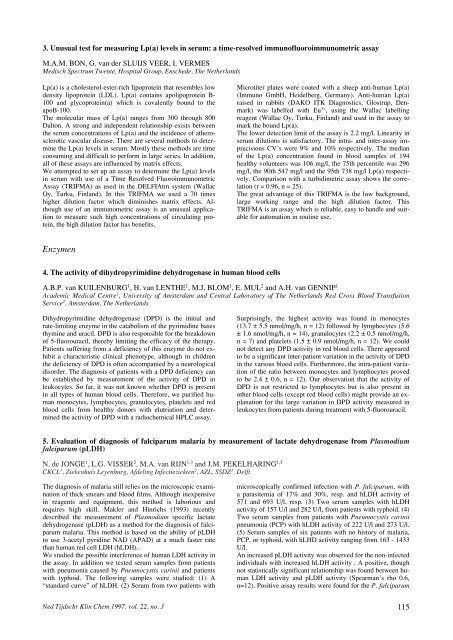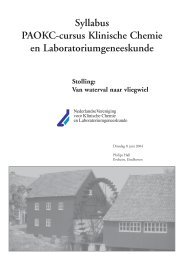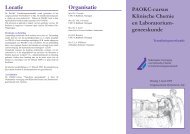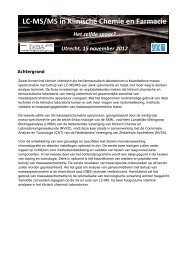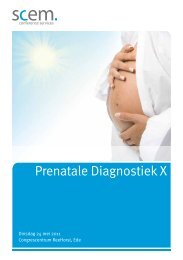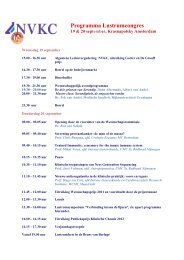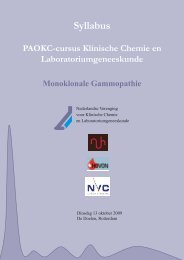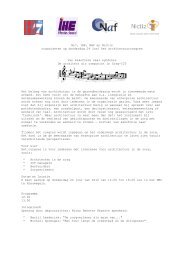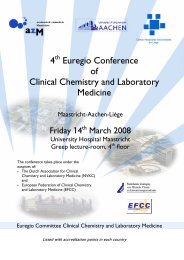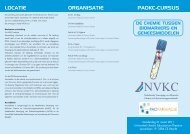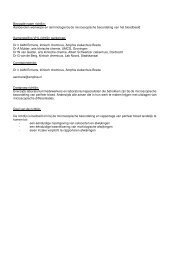Klinische (bio)chemie en methodologie - NVKC
Klinische (bio)chemie en methodologie - NVKC
Klinische (bio)chemie en methodologie - NVKC
You also want an ePaper? Increase the reach of your titles
YUMPU automatically turns print PDFs into web optimized ePapers that Google loves.
3. Unusual test for measuring Lp(a) levels in serum: a time-resolved immunofluoroimmunometric assay<br />
M.A.M. BON, G. van der SLUIJS VEER, I. VERMES<br />
Medisch Spectrum Tw<strong>en</strong>te, Hospital Group, Enschede, The Netherlands<br />
Lp(a) is a cholesterol-ester-rich lipoprotein that resembles low<br />
d<strong>en</strong>sity lipoprotein (LDL). Lp(a) contains apolipoprotein B-<br />
100 and glycoprotein(a) which is coval<strong>en</strong>tly bound to the<br />
apoB-100.<br />
The molecular mass of Lp(a) ranges from 300 through 800<br />
Dalton. A strong and indep<strong>en</strong>d<strong>en</strong>t relationship exists betwe<strong>en</strong><br />
the serum conc<strong>en</strong>trations of Lp(a) and the incid<strong>en</strong>ce of atherosclerotic<br />
vascular disease. There are several methods to determine<br />
the Lp(a) levels in serum. Mostly these methods are time<br />
consuming and difficult to perform in large series. In addition,<br />
all of these assays are influ<strong>en</strong>ced by matrix effects.<br />
We attempted to set up an assay to determine the Lp(a) levels<br />
in serum with use of a Time Resolved Fluoroimmunometric<br />
Assay (TRIFMA) as used in the DELFIAtm system (Wallac<br />
Oy, Turku, Finland). In this TRIFMA we used a 70 times<br />
higher dilution factor which diminishes matrix effects. Although<br />
use of an immunometric assay is an unusual application<br />
to measure such high conc<strong>en</strong>trations of circulating protein,<br />
the high dilution factor has b<strong>en</strong>efits.<br />
Enzym<strong>en</strong><br />
4. The activity of dihydropyrimidine dehydrog<strong>en</strong>ase in human blood cells<br />
Dihydropyrimidine dehydrog<strong>en</strong>ase (DPD) is the initial and<br />
rate-limiting <strong>en</strong>zyme in the catabolism of the pyrimidine bases<br />
thymine and uracil. DPD is also responsible for the breakdown<br />
of 5-fluorouracil, thereby limiting the efficacy of the therapy.<br />
Pati<strong>en</strong>ts suffering from a defici<strong>en</strong>cy of this <strong>en</strong>zyme do not exhibit<br />
a characteristic clinical ph<strong>en</strong>otype, although in childr<strong>en</strong><br />
the defici<strong>en</strong>cy of DPD is oft<strong>en</strong> accompanied by a neurological<br />
disorder. The diagnosis of pati<strong>en</strong>ts with a DPD defici<strong>en</strong>cy can<br />
be established by measurem<strong>en</strong>t of the activity of DPD in<br />
leukocytes. So far, it was not known whether DPD is pres<strong>en</strong>t<br />
in all types of human blood cells. Therefore, we purified human<br />
monocytes, lymphocytes, granulocytes, platelets and red<br />
blood cells from healthy donors with elutriation and determined<br />
the activity of DPD with a radiochemical HPLC assay.<br />
Ned Tijdschr Klin Chem 1997, vol. 22, no. 3<br />
Microtiter plates were coated with a sheep anti-human Lp(a)<br />
(Immuno GmbH, Heidelberg, Germany). Anti-human Lp(a)<br />
raised in rabbits (DAKO ITK Diagnostics, Glostrup, D<strong>en</strong>mark)<br />
was labelled with Eu 3+ , using the Wallac labelling<br />
reag<strong>en</strong>t (Wallac Oy, Turku, Finland) and used in the assay to<br />
mark the bound Lp(a).<br />
The lower detection limit of the assay is 2.2 mg/l. Linearity in<br />
serum dilutions is satisfactory. The intra- and inter-assay imprecisions<br />
CV’s were 9% and 10% respectively. The median<br />
of the Lp(a) conc<strong>en</strong>tration found in blood samples of 194<br />
healthy volunteers was 106 mg/l, the 75th perc<strong>en</strong>tile was 296<br />
mg/l, the 90th 547 mg/l and the 95th 738 mg/l Lp(a) respectively.<br />
Comparison with a turbidimetric assay shows the correlation<br />
(r = 0.96, n = 25).<br />
The great advantage of this TRIFMA is the low background,<br />
large working range and the high dilution factor. This<br />
TRIFMA is an assay which is reliable, easy to handle and suitable<br />
for automation in routine use.<br />
A.B.P. van KUILENBURG 1 , H. van LENTHE 1 , M.J. BLOM 1 , E. MUL 2 and A.H. van GENNIP 1<br />
Academic Medical C<strong>en</strong>tre 1 , University of Amsterdam and C<strong>en</strong>tral Laboratory of The Netherlands Red Cross Blood Transfusion<br />
Service 2 , Amsterdam, The Netherlands<br />
Surprisingly, the highest activity was found in monocytes<br />
(13.7 ± 5.5 nmol/mg/h, n = 12) followed by lymphocytes (5.6<br />
± 1.6 nmol/mg/h, n = 14), granulocytes (2.2 ± 0.5 nmol/mg/h,<br />
n = 7) and platelets (1.5 ± 0.9 nmol/mg/h, n = 12). We could<br />
not detect any DPD activity in red blood cells. There appeared<br />
to be a significant inter-pati<strong>en</strong>t variation in the activity of DPD<br />
in the various blood cells. Furthermore, the intra-pati<strong>en</strong>t variation<br />
of the ratio betwe<strong>en</strong> monocytes and lymphocytes proved<br />
to be 2.4 ± 0.6, n = 12). Our observation that the activity of<br />
DPD is not restricted to lymphocytes but is also pres<strong>en</strong>t in<br />
other blood cells (except red blood cells) might provide an explanation<br />
for the large variation in DPD activity measured in<br />
leukocytes from pati<strong>en</strong>ts during treatm<strong>en</strong>t with 5-fluorouracil.<br />
5. Evaluation of diagnosis of falciparum malaria by measurem<strong>en</strong>t of lactate dehydrog<strong>en</strong>ase from Plasmodium<br />
falciparum (pLDH)<br />
N. de JONGE 1 , L.G. VISSER 2 , M.A. van RIJN 1,3 and J.M. PEKELHARING 1,3<br />
CKCL 1 , Ziek<strong>en</strong>huis Ley<strong>en</strong>burg, Afdeling Infectieziekt<strong>en</strong> 2 , AZL, SSDZ 3 , Delft<br />
The diagnosis of malaria still relies on the microscopic examination<br />
of thick smears and blood films. Although inexp<strong>en</strong>sive<br />
in reag<strong>en</strong>ts and equipm<strong>en</strong>t, this method is laborious and<br />
requires high skill. Makler and Hinrichs (1993) rec<strong>en</strong>tly<br />
described the measurem<strong>en</strong>t of Plasmodium specific lactate<br />
dehydrog<strong>en</strong>ase (pLDH) as a method for the diagnosis of falciparum<br />
malaria. This method is based on the ability of pLDH<br />
to use 3-acetyl pyridine NAD (APAD) at a much faster rate<br />
than human red cell LDH (hLDH).<br />
We studied the possible interfer<strong>en</strong>ce of human LDH activity in<br />
the assay. In addition we tested serum samples from pati<strong>en</strong>ts<br />
with pneumonia caused by Pneumocystis carinii and pati<strong>en</strong>ts<br />
with typhoid. The following samples were studied: (1) A<br />
“standard curve” of hLDH. (2) Serum from two pati<strong>en</strong>ts with<br />
microscopically confirmed infection with P. falciparum, with<br />
a parasitemia of 17% and 30%, resp. and hLDH activity of<br />
571 and 693 U/l, resp. (3) Two serum samples with hLDH<br />
activity of 157 U/l and 282 U/l, from pati<strong>en</strong>ts with typhoid. (4)<br />
Two serum samples from pati<strong>en</strong>ts with Pneumocystis carinii<br />
pneumonia (PCP) with hLDH activity of 222 U/l and 273 U/l.<br />
(5) Serum samples of six pati<strong>en</strong>ts with no history of malaria,<br />
PCP, or typhoid, with hLHD activity ranging from 163 - 1433<br />
U/l.<br />
An increased pLDH activity was observed for the non-infected<br />
individuals with increased hLDH activity . A positive, though<br />
not statistically significant relationship was found betwe<strong>en</strong> human<br />
LDH activity and pLDH activity (Spearman’s rho 0.6,<br />
n=12). Positive assay results were found for the P. falciparum<br />
115


